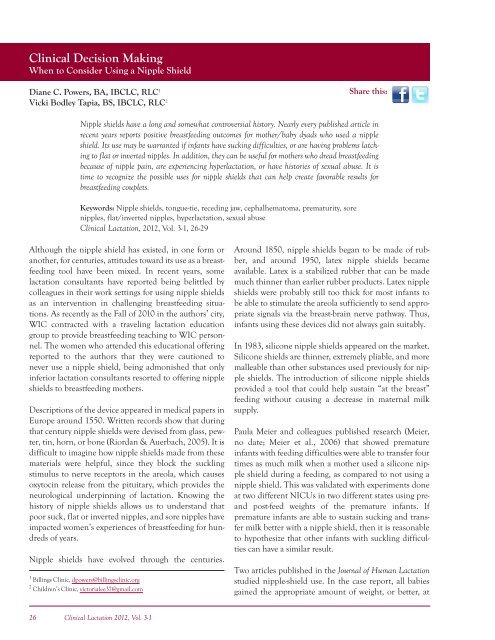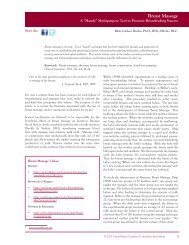Official Journal of the United States Lactation ... - Clinical Lactation
Official Journal of the United States Lactation ... - Clinical Lactation
Official Journal of the United States Lactation ... - Clinical Lactation
You also want an ePaper? Increase the reach of your titles
YUMPU automatically turns print PDFs into web optimized ePapers that Google loves.
<strong>Clinical</strong> Decision Making<br />
When to Consider Using a Nipple Shield<br />
Diane C. Powers, BA, IBCLC, RLC 1<br />
Vicki Bodley Tapia, BS, IBCLC, RLC 2<br />
Share this:<br />
Nipple shields have a long and somewhat controversial history. Nearly every published article in<br />
recent years reports positive breastfeeding outcomes for mo<strong>the</strong>r/baby dyads who used a nipple<br />
shield. Its use may be warranted if infants have sucking difficulties, or are having problems latching<br />
to flat or inverted nipples. In addition, <strong>the</strong>y can be useful for mo<strong>the</strong>rs who dread breastfeeding<br />
because <strong>of</strong> nipple pain, are experiencing hyperlactation, or have histories <strong>of</strong> sexual abuse. It is<br />
time to recognize <strong>the</strong> possible uses for nipple shields that can help create favorable results for<br />
breastfeeding couplets.<br />
Keywords: Nipple shields, tongue-tie, receding jaw, cephalhematoma, prematurity, sore<br />
nipples, flat/inverted nipples, hyperlactation, sexual abuse<br />
<strong>Clinical</strong> <strong>Lactation</strong>, 2012, Vol. 3-1, 26-29<br />
Although <strong>the</strong> nipple shield has existed, in one form or<br />
ano<strong>the</strong>r, for centuries, attitudes toward its use as a breastfeeding<br />
tool have been mixed. In recent years, some<br />
lactation consultants have reported being belittled by<br />
colleagues in <strong>the</strong>ir work settings for using nipple shields<br />
as an intervention in challenging breastfeeding situations.<br />
As recently as <strong>the</strong> Fall <strong>of</strong> 2010 in <strong>the</strong> authors’ city,<br />
WIC contracted with a traveling lactation education<br />
group to provide breastfeeding teaching to WIC personnel.<br />
The women who attended this educational <strong>of</strong>fering<br />
reported to <strong>the</strong> authors that <strong>the</strong>y were cautioned to<br />
never use a nipple shield, being admonished that only<br />
inferior lactation consultants resorted to <strong>of</strong>fering nipple<br />
shields to breastfeeding mo<strong>the</strong>rs.<br />
Descriptions <strong>of</strong> <strong>the</strong> device appeared in medical papers in<br />
Europe around 1550. Written records show that during<br />
that century nipple shields were devised from glass, pewter,<br />
tin, horn, or bone (Riordan & Auerbach, 2005). It is<br />
difficult to imagine how nipple shields made from <strong>the</strong>se<br />
materials were helpful, since <strong>the</strong>y block <strong>the</strong> suckling<br />
stimulus to nerve receptors in <strong>the</strong> areola, which causes<br />
oxytocin release from <strong>the</strong> pituitary, which provides <strong>the</strong><br />
neurological underpinning <strong>of</strong> lactation. Knowing <strong>the</strong><br />
history <strong>of</strong> nipple shields allows us to understand that<br />
poor suck, flat or inverted nipples, and sore nipples have<br />
impacted women’s experiences <strong>of</strong> breastfeeding for hundreds<br />
<strong>of</strong> years.<br />
Nipple shields have evolved through <strong>the</strong> centuries.<br />
1 Billings Clinic, dpowers@billingsclinic.org<br />
2 Children’s Clinic, victorialee37@gmail.com<br />
Around 1850, nipple shields began to be made <strong>of</strong> rubber,<br />
and around 1950, latex nipple shields became<br />
available. Latex is a stabilized rubber that can be made<br />
much thinner than earlier rubber products. Latex nipple<br />
shields were probably still too thick for most infants to<br />
be able to stimulate <strong>the</strong> areola sufficiently to send appropriate<br />
signals via <strong>the</strong> breast-brain nerve pathway. Thus,<br />
infants using <strong>the</strong>se devices did not always gain suitably.<br />
In 1983, silicone nipple shields appeared on <strong>the</strong> market.<br />
Silicone shields are thinner, extremely pliable, and more<br />
malleable than o<strong>the</strong>r substances used previously for nipple<br />
shields. The introduction <strong>of</strong> silicone nipple shields<br />
provided a tool that could help sustain “at <strong>the</strong> breast”<br />
feeding without causing a decrease in maternal milk<br />
supply.<br />
Paula Meier and colleagues published research (Meier,<br />
no date; Meier et al., 2006) that showed premature<br />
infants with feeding difficulties were able to transfer four<br />
times as much milk when a mo<strong>the</strong>r used a silicone nipple<br />
shield during a feeding, as compared to not using a<br />
nipple shield. This was validated with experiments done<br />
at two different NICUs in two different states using preand<br />
post-feed weights <strong>of</strong> <strong>the</strong> premature infants. If<br />
premature infants are able to sustain sucking and transfer<br />
milk better with a nipple shield, <strong>the</strong>n it is reasonable<br />
to hypo<strong>the</strong>size that o<strong>the</strong>r infants with suckling difficulties<br />
can have a similar result.<br />
Two articles published in <strong>the</strong> <strong>Journal</strong> <strong>of</strong> Human <strong>Lactation</strong><br />
studied nipple-shield use. In <strong>the</strong> case report, all babies<br />
gained <strong>the</strong> appropriate amount <strong>of</strong> weight, or better, at<br />
26 <strong>Clinical</strong> <strong>Lactation</strong> 2012, Vol. 3-1




